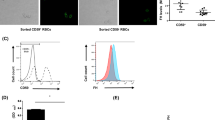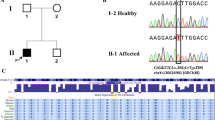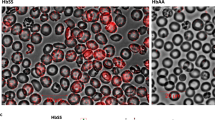Abstract
Fc receptors on phagocytic cells in the blood mediate binding and clearance of immune complexes, phagocytosis of antibody-opsonized microorganisms, and potently trigger effector functions, including superoxide anion production and antibody-dependent cellular cytotoxicity. The Fc receptor type HI (FcγR III, CD 16), present in 135,000 sites per cell 1 on neutrophils and accounting for most of FcR in blood, unexpectedly has a phosphatidylinositol glycan (PIG) membrane anchor. Deficiency of FcγR III is observed in paroxysmal nocturnal haemoglobinuria (PNH), an acquired abnormality of haematopoietic cells2 affecting PIG tail biosynthesis or attachment3, and is prbably responsible for circulating immune complexes4 and susceptibility to bacterial infections associated with this disease5. Although a growing number of eukaryotic cell-surface proteins with PIG-tails are being described6,7, none has thus far been implicated in receptor-mediated endocytosis or in triggering of cell-mediated killing. Our findings on the FcγR III raise the question of how a PIG-tailed protein important in immune complex clearance in vivo8,9 and in antibody-dependent killing10 mediates ligand internalization and cytotoxicity. Together with our results, previous functional studies on FcγR III and FcγR II11,12 suggest that these two receptors may cooperate and that the type of membrane anchor is an important mechanism whereby the functional capacity of surface receptors can be regulated.
This is a preview of subscription content, access via your institution
Access options
Subscribe to this journal
Receive 51 print issues and online access
$199.00 per year
only $3.90 per issue
Buy this article
- Purchase on Springer Link
- Instant access to full article PDF
Prices may be subject to local taxes which are calculated during checkout
Similar content being viewed by others
References
Fleit, H. B., Wright, S. D. & Unkeless, J. C. Proc. natn. Acad. Sci. U.S.A. 79, 3275–3279 (1982).
Rosse, W. F. & Parker, C. J. Clin. Haemat. 14, 105–125 (1985).
Low, M. G. Biochem. J. 244, 1–13 (1987).
Villaescusa, R. Acta haemat. 68, 136–141 (1982).
Crosby, W. H. Blood 8, 769–812 (1953).
Low, M. G. & Saltiel, A. R. Science 239, 268–275 (1988).
Ferguson, M. A. J. & Williams, A. F. A. Rev. Biochem. (in the press).
Clarkson, S. B., Bussel, J. B., Kimberley, R. P., Valinsky, J. E., Nachman, R. L. & Unkeless, J. C. N. Engl. J. Med. 314, 123–129 (1986).
Clarkson, S. B. et al. J. exp. Med. 164, 474–489 (1986).
Perussia, B. et al. J. Immun. 130, 2142–2148 (1983).
Shen, L., Gure, M. & Fanger, M. W. J. Immun. 139, 534–538 (1987).
Graziano, R. F. & Fanger, M. W. J. Immun. 139, 3536–3541 (1987).
Anderson, C. L. & Looney, R. J. Immun. Today 7, 264–266 (1986).
Tetteroo, P. A. T., Van Der Schoot, C. E., Visser, F. J., Bos, M. J. E. & Von deme Borne, A. E. G. in Leucocyte typing III (eds McMichael, A. J. et al.) 702–706 (Oxford University Press, Oxford, 1987).
Nicholson-Weller, A., Spicer, D. B. & Austen, K. F. New Engl. J. Med. 312, 1091–1097 (1985).
Kinoshita, T., Medof, M. E., Silber, R. & Nussenzweig, V. J. exp. Med. 162, 75–92 (1985).
Stuart, S. G. et al. J. exp. Med. 166, 1668–1684 (1987).
Werner, G. et al. in Leukocyte Typing II (eds Reinherz, E. L., Haynes, B. F., Nadler, L. M. & Bernstein, I. D.) 109–121 (Springer, New York, 1986).
Khayat, D. et al. J. immunol. Meth. 100, 235–241 (1987).
Reiser, H. et al. Cell 47, 365–370 (1986).
Kroczek, R. A., Gunter, K. C., Seligman, B. & Shevach, E. M. J. Immun. 136, 4379–4384 (1986).
Looney, R. J. et al. J. exp. Med. 163, 826–836 (1986).
Karas, S. P., Rosse, W. F. & Kurlander, R. J. Blood 60, 1277–1282 (1982).
Vaughan, M., Taylor, M. & Mohankumar, T. J. Immun. 135, 4059–4065 (1985).
Williams, W. J., Beutler, E., Erselev, A. J. & Lichtman, M. N. Hematology (McGraw-Hill, New York, 1983).
Miller, L. J., Bainton, D. F., Borregaard, N. & Springer, T. A. J. clin. Invest. 80, 535–544 (1987).
Anderson, C. L. et al. J. immun. 261, 12856–12864 (1986).
Fraker, P. J. & Speck, J. C. Biochem. biophys. Res. Commun. 80, 849–857 (1978).
Laemmli, U. K. Nature 227, 680–685 (1970).
Author information
Authors and Affiliations
Rights and permissions
About this article
Cite this article
Selvaraj, P., Rosse, W., Silber, R. et al. The major Fc receptor in blood has a phosphatidylinositol anchor and is deficient in paroxysmal nocturnal haemoglobinuria. Nature 333, 565–567 (1988). https://doi.org/10.1038/333565a0
Received:
Accepted:
Issue Date:
DOI: https://doi.org/10.1038/333565a0
This article is cited by
-
Fcγ receptors and immunomodulatory antibodies in cancer
Nature Reviews Cancer (2024)
-
Fc receptor-mediated phagocytosis in tissues as a potent mechanism for preventive and therapeutic HIV vaccine strategies
Mucosal Immunology (2016)
-
Fibrinolytic therapy with rt-PA in a patient with paroxysmal nocturnal hemoglobinuria and Budd-Chiari syndrome
Annals of Hematology (2003)
Comments
By submitting a comment you agree to abide by our Terms and Community Guidelines. If you find something abusive or that does not comply with our terms or guidelines please flag it as inappropriate.



